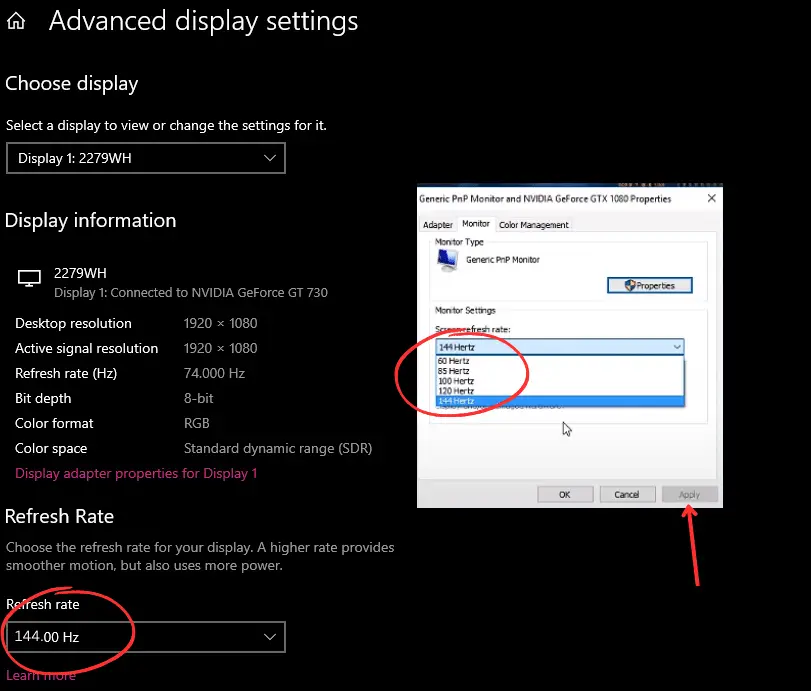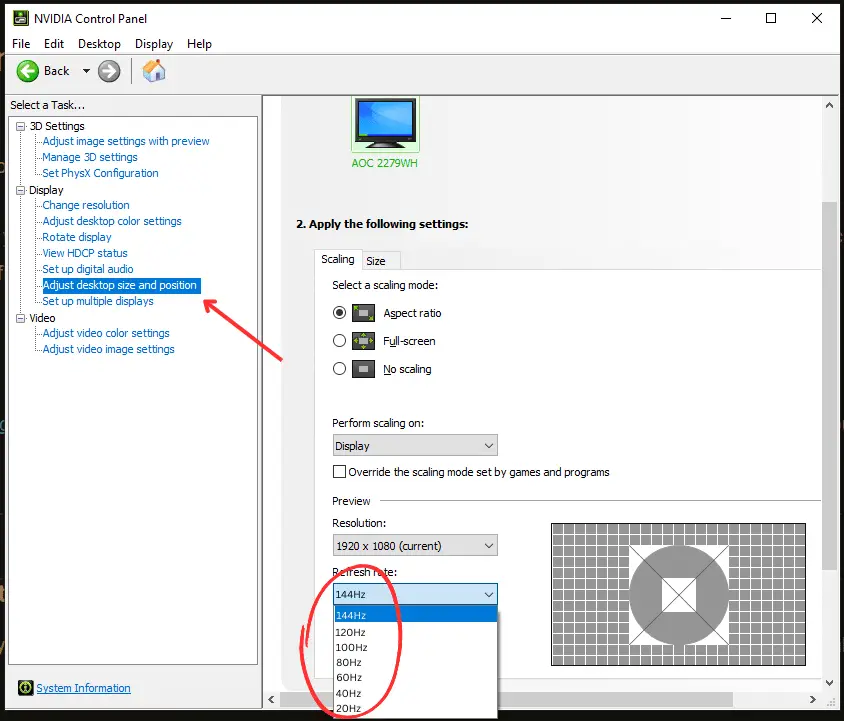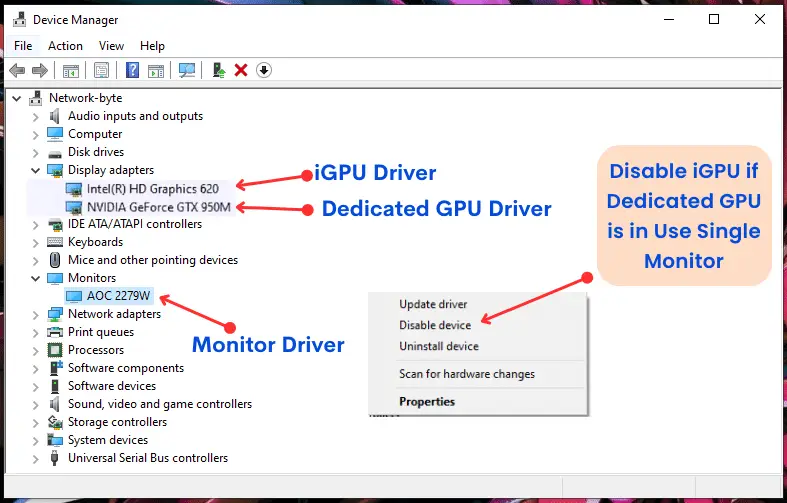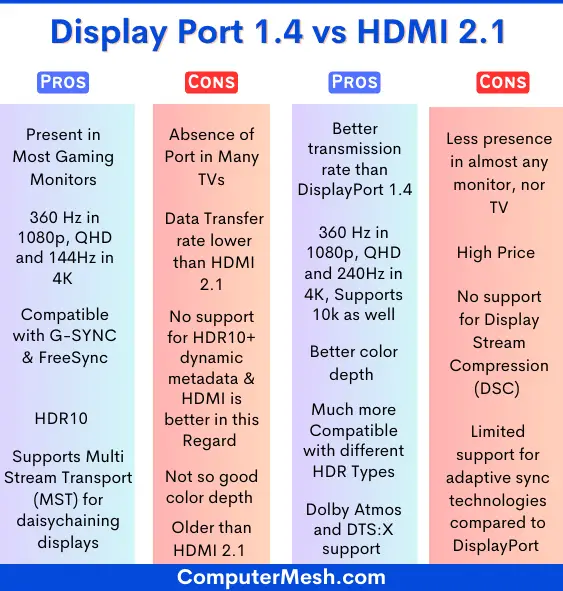Gaming Monitor Isn’t Running on 144Hz – 5 Reasons & Fixes.
Here I explain why your gaming monitor, which supports 144Hz, is not running the game at that refresh rate?
Discussing what could be causing your monitor not to run at its maximum refresh rate and provide step-by-step instructions to increase your monitor’s refresh rate to run at its full potential?
What is the Reason why 144Hz is not Output,
Even though it is a 144Hz Gaming Monitor?
If you are using a regular or a gaming monitor that is capable to support 144Hz or higher, but you are getting lower than that or just 60FPS, there could be a few potential causes.
1. Your Windows Setting is set to a Limit
Ensure your Windows Operating System is set at 144Hz refresh rate. Even if you use a 144Hz monitor, only 60fps will be output unless you change it yourself.
To do this, right-click anywhere on the desktop and select Display Settings (or Screen Resolution). Click Advanced display settings, and under “Display adapter properties,” click the Monitor tab. When you select the refresh rate pulldown, the corresponding list of Hz available will appear, if you find it, select 144 Hz and set it.

For a dual display setup, you need to set each display to the same refresh rate.
Here the maximum hz means the high limit of the monitor’s refresh rate. If it is lower than 144Hz, then the graphics card is not able to provide a signal at that refresh rate.
2. GPU Settings are Limiting the Refresh Rate
You may also have the GPU settings set to a lower refresh rate than 144Hz. Open your graphics card’s control panel (NVIDIA Control Panel or AMD Catalyst Control Center) to check this.
In the case of Nvidia, open the Nvidia Control Panel and navigate to “adjust desktop and position” from the left pane under the Display section. On the right side, when you select the pull-down of the “Refresh rate” item, the maximum Hz will appear, so set the highest Hz. Finally, click Apply after making changes.

In the case of AMD, open AMD Catalyst Control Center and select the Graphics tab. Like the Nvidia Control Panel, find the “Max FPS” and scroll right to set the highest Hz.
If you don’t have a powerful GPU enough, it may be unable to adjust your refresh rate higher than the default.
3. Problem with drivers
In older computers, there may be a problem with the video card drivers. In new PCs, this is much less common. The easiest solution is to uninstall the Monitor driver completely and reinstall driver again. It is essential not to use automatic installation programs for such software but to do everything manually.
Uninstallation is performed in the Windows Device Manager, and the desired file is available on the Nvidia and AMD websites.
Is Integrated GPU’s Driver Disabled?
Sometimes an iGPU (integrated GPU) clashes with the refresh rate as the driver of the integrated graphics will cause conflicts with your dedicated GPU’s driver. It is better to disable the driver if it is automatically enabled.
To disable this, open Device Manager -> Display adapter and find any driver related to “Intel HD Graphics” or “AMD Radeon” in the list. Right-click on that entry and select Disable device for each of them.

Now restart your PC after all these changes, and if you have done everything correctly, you should be able to choose the refresh rate of 144Hz.
4. Don’t Plug the Monitor Cable into the Motherboard
Do you aware that motherboard also has HDMI, VGA and Display ports? If your monitor is plugged into the motherboard’s port, that could be why the refresh rate is lower, the motherboard’s port won’t let you go beyond maximum Hz. Recheck that the cable is plugged into your GPU board, not the motherboard.
5. Is your Cable Suitable or Not for 144Hz?
If you expect a high refresh rate, you should pay attention to the cable that come with your monitor connects with GPU.
A cheap, low-quality cable can cause issues like screen flickering and slow refresh rates, response time, in this case, you should replace that cable with a high-quality newer version because an older version does not support high Hz signals.
HDMI or DisplayPort cables you use must be rated for high bandwidth signaling, such as “High Speed” (18Gbps) and not standard speed (10.2Gbps). You’ll only get lower FPS without the proper cable, no matter what settings you change.
If you are using an HDMI cable, check that it is version 1.4 or newer, as these cables are necessary for higher refresh rates like 120Hz or 144Hz at 1080p.
For a DisplayPort cable, version 1.2 or newer support higher refresh rates like 120Hz or 144Hz at 1080p. If your cable version is older than this, you should upgrade to get your monitor’s maximum refresh rate and resolution.
For DVI-A, DVI-D, DVI-I and VGA cables and ports, the refresh rate is limited and lower, no matter the cable version. Therefore, you’ll need an HDMI or DisplayPort cable for 120hz & 144hz.

Compatibility
Also, does your monitor support this version? This is often overlooked but can cause issues with higher refresh rates like ghosting on screen. Check the specifications for your monitor to make sure it matches up with the newer cable versions.
The same applies to Graphics Cards. Ensure your Graphics Card like GTX or Ti can support interface standards like HDMI 1.4 or DisplayPort 1.2 to get maximum refresh rates and resolution.
For a detailed explanation of cables, please refer to “Differences between DisplayPort and HDMI versions.”
It is Set to 144Hz, Still I can’t feel the Effect – PC specs are the Cause.
If you cannot feel the effect of 144Hz even though the above settings are set correctly, your PC specs may not be powerful enough to support a high refresh rate. Even though a monitor can output up to 144fps, it’s a waste of money that the PC doesn’t have enough specs to output 144fps.
It can be improved somewhat by lowering the modifying of the PC itself, optimizing game settings, Vysnc on or off, or even other background tasks running on your system and taking up resources. However, considering the future, it would be better to replace it with gaming specs that support output of 144fps or more.
For example, if you are using a GeForce GTX 1060 graphics card with an i5 7600 CPU, you should be able to run most games at above 144FPS, providing your settings are optimized correctly.
Tip – If you have doubts about your setup’s performance, running a benchmarking tool such as 3DMark is best to test how well your hardware performs. This will give you an idea of the FPS you can expect to achieve in your current settings.
However, keep in mind that not only the frequency is important, but also the resolution. The monitor size measuring may support 4k and it is written that it works at 144 Hz, but not at the same time. It is necessary to read the technical specifications, perhaps in FHD 144 Hz and in 4k – only 60 Hz.
